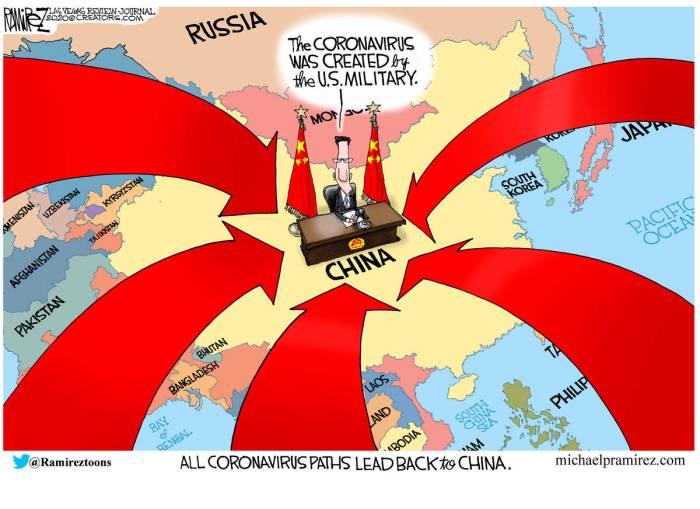
Some reaction at last.
Over 7,000 Scientists, Doctors Call For COVID Herd Immunity, End To Lockdowns
Authored by Steve Watson via Summit News,
Over six thousand scientists and doctors have signed a petition against coronavirus lockdown measures, urging that those not in the at risk category should be able to get on with their lives as normal, and that lockdown rules in both the US and UK are causing ‘irreparable damage’.
Those who have signed include professors from the world’s leading universities.
Oxford University professor Dr Sunetra Gupta was one of the authors of the open letter that was sent with the petition, along with Harvard University’s Dr Martin Kulldorff and Stanford’s Dr Jay Bhattacharya.
It declares that social distancing and mask mandates are causing ‘damaging physical and mental health impacts.’
The petition, dubbed the Great Barrington Declaration after the town in Massachusetts where it was written, has been signed by close to 73,000 members of the public at time of writing, as well as over 4,700 medical and public health scientists and around 3,200 medical practitioners.
“Those who are not vulnerable should immediately be allowed to resume life as normal,” it notes, adding “Keeping these [lockdown] measures in place until a vaccine is available will cause irreparable damage, with the underprivileged disproportionately harmed.”
“Current lockdown policies are producing devastating effects on short and long-term public health,” the declaration also declares.
It continues, “The results (to name a few) include lower childhood vaccination rates, worsening cardiovascular [heart] disease outcomes, fewer cancer screenings and deteriorating mental health – leading to greater excess mortality in years to come, with the working class and younger members of society carrying the heaviest burden.”
“Keeping students out of school is a grave injustice,” the declaration adds.
“Those who are not vulnerable should immediately be allowed to resume life as normal, it concludes, explaining that “Simple hygiene measures, such as hand washing and staying home when sick should be practiced by everyone to reduce the herd immunity threshold.”
“Schools and universities should be open for in-person teaching. Extracurricular activities, such as sports, should be resumed. Young low-risk adults should work normally, rather than from home,” it emphasises.
Finally, the declaration demands that normal life should resume, stating that “Restaurants and other businesses should open. Arts, music, sport and other cultural activities should resume. People who are more at risk may participate if they wish, while society as a whole enjoys the protection conferred upon the vulnerable by those who have built up herd immunity.”
The declaration echoes President Trump’s words earlier this week when he returned to the White House and asked Americans not to live in fear or let let the virus dominate their everyday lives:
The declaration dovetails with other research that has concluded lockdowns will conservatively “destroy at least seven times more years of human life” than they save.
Germany’s Minister of Economic Cooperation and Development, Gerd Muller, has warned that lockdown measures throughout the globe will end up killing more people than the Coronavirus itself.
In an interview with German newspaper Handelsblatt, Muller warned that the response to the global pandemic has resulted in “one of the biggest” hunger and poverty crises in history.
Muller’s comments come five months after a leaked study from inside the German Ministry of the Interior revealed that the impact of the country’s lockdown could end up killing more people than the coronavirus due to victims of other serious illnesses not receiving treatment.
As we have previously highlighted, in the UK there have already been up to 10,000 excess deaths as a result of seriously ill people avoiding hospitals due to COVID-19 or not having their hospital treatments cancelled.
Professor Richard Sullivan also warned that there will be more excess cancer deaths in the UK than total coronavirus deaths due to people’s access to screenings and treatment being restricted as a result of the lockdown.
His comments were echoed by Peter Nilsson, a Swedish professor of internal medicine and epidemiology at Lund University, who said, “It’s so important to understand that the deaths of COVID-19 will be far less than the deaths caused by societal lockdown when the economy is ruined.”
According to Professor Karol Sikora, an NHS consultant oncologist, there could be 50,000 excess deaths from cancer as a result of routine screenings being suspended during the lockdown in the UK.
In addition, a study published in The Lancet that notes “physical distancing, school closures, trade restrictions, and country lockdowns” are worsening global child malnutrition.
Experts have also warned that there will be 1.4 million deaths globally from untreated TB infections due to the lockdown.
As we further previously highlighted, a data analyst consortium in South Africa found that the economic consequences of the country’s lockdown will lead to 29 times more people dying than the coronavirus itself.Hundreds of doctors are also on record as opposing lockdown measures, warning that they will cause more death than the coronavirus itself.
Despite citizens across the world being told to observe the lockdown to “save lives,” numerous experts who are now warning that the lockdown could end up costing more lives are being ignored or smeared by the media.
* * *
The Great Barrington Declaration
As infectious disease epidemiologists and public health scientists we have grave concerns about the damaging physical and mental health impacts of the prevailing COVID-19 policies, and recommend an approach we call Focused Protection.
Coming from both the left and right, and around the world, we have devoted our careers to protecting people. Current lockdown policies are producing devastating effects on short and long-term public health. The results (to name a few) include lower childhood vaccination rates, worsening cardiovascular disease outcomes, fewer cancer screenings and deteriorating mental health – leading to greater excess mortality in years to come, with the working class and younger members of society carrying the heaviest burden. Keeping students out of school is a grave injustice.
Keeping these measures in place until a vaccine is available will cause irreparable damage, with the underprivileged disproportionately harmed.
Fortunately, our understanding of the virus is growing. We know that vulnerability to death from COVID-19 is more than a thousand-fold higher in the old and infirm than the young. Indeed, for children, COVID-19 is less dangerous than many other harms, including influenza.
As immunity builds in the population, the risk of infection to all – including the vulnerable – falls. We know that all populations will eventually reach herd immunity – i.e. the point at which the rate of new infections is stable – and that this can be assisted by (but is not dependent upon) a vaccine. Our goal should therefore be to minimize mortality and social harm until we reach herd immunity.
The most compassionate approach that balances the risks and benefits of reaching herd immunity, is to allow those who are at minimal risk of death to live their lives normally to build up immunity to the virus through natural infection, while better protecting those who are at highest risk. We call this Focused Protection.
Adopting measures to protect the vulnerable should be the central aim of public health responses to COVID-19. By way of example, nursing homes should use staff with acquired immunity and perform frequent PCR testing of other staff and all visitors. Staff rotation should be minimized. Retired people living at home should have groceries and other essentials delivered to their home. When possible, they should meet family members outside rather than inside. A comprehensive and detailed list of measures, including approaches to multi-generational households, can be implemented, and is well within the scope and capability of public health professionals.
Those who are not vulnerable should immediately be allowed to resume life as normal. Simple hygiene measures, such as hand washing and staying home when sick should be practiced by everyone to reduce the herd immunity threshold. Schools and universities should be open for in-person teaching. Extracurricular activities, such as sports, should be resumed. Young low-risk adults should work normally, rather than from home. Restaurants and other businesses should open. Arts, music, sport and other cultural activities should resume. People who are more at risk may participate if they wish, while society as a whole enjoys the protection conferred upon the vulnerable by those who have built up herd immunity.







